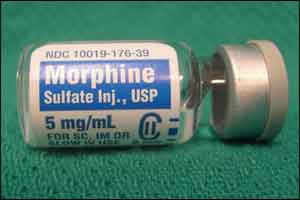- Home
- Editorial
- News
- Practice Guidelines
- Anesthesiology Guidelines
- Cancer Guidelines
- Cardiac Sciences Guidelines
- Critical Care Guidelines
- Dentistry Guidelines
- Dermatology Guidelines
- Diabetes and Endo Guidelines
- Diagnostics Guidelines
- ENT Guidelines
- Featured Practice Guidelines
- Gastroenterology Guidelines
- Geriatrics Guidelines
- Medicine Guidelines
- Nephrology Guidelines
- Neurosciences Guidelines
- Obs and Gynae Guidelines
- Ophthalmology Guidelines
- Orthopaedics Guidelines
- Paediatrics Guidelines
- Psychiatry Guidelines
- Pulmonology Guidelines
- Radiology Guidelines
- Surgery Guidelines
- Urology Guidelines
25 Million Die in Pain Each Year For Want Morphine

Every year, some 25 million people -- one in ten of them children -- die in serious pain that could have been alleviated with morphine at just a few cents per dose, researchers said Friday.
This represents nearly half of all deaths globally each year, they reported in The Lancet medical journal, warning of a "global pain crisis."
The vast majority of people denied pain relief lived in low- and middle-income countries, which received less than four percent of the 299 tonnes of oral morphine distributed around the world, said the team.
On the other side of the spectrum, abuse of opioid-based pain-killers was common in some rich nations, nowhere more so than the United States.
"The pain gap is a double-edged sword with too little access to inexpensive opioids for poor nations and misuse by rich ones," said study co-author Julio Frenk of the University of Miami.
Opioids are drugs that include codeine and morphine for pain relief, but also heroin.
Not only was morphine harder to find in poor countries, it was also more expensive -- at about 16 US cents for 10 milligrams compared to three cents in rich nations, the report said.
"We estimate that the cost of meeting the global shortfall of about 48.5 metric tonnes of morphine-equivalent opioids is about $145 million (122 million euros) per year if all countries had access to the lowest retail prices paid by some high-income countries," the team wrote.
This was "a fraction of the cost" of running a medium-sized American hospital, and "a pittance" compared to the estimated $100 billion a year spent on the war on recreational drugs, said Frenk's colleague Felicia Knaul.
Children dying in pain
"The biggest shame is children in low-income countries dying in pain which could be eliminated for $1 million a year," she said.
The cost was not the only problem, the team noted.
"Failure of health systems in poor countries is a major reason that patients need palliative care in the first place," World Bank president Jim Yong Kim said in a statement.
"More than 90 percent of these child deaths are from avoidable causes."
The report was compiled by experts analysing the need for palliative care due to 20 life-threatening diseases such as HIV, cancer, heart disease, premature birth, tuberculosis, haemorrhagic fevers, lung and liver diseases, malnutrition, dementia, and trauma injuries.
Of the 172 countries studied, 25 had essentially no morphine, while a further 15 had enough to meet less than one percent of pain relief requirements.
A hundred countries could meet the standard pain relief needs of less than a third of patients, the study found.
"This global pain crisis can be remedied quickly and effectively," said Knaul. "We have the right tools and knowledge and the cost of the solution is minimal.
"Denying this intervention is a moral failing, especially for children and patients at the end of life."
Another 35 million sick people who did not die also had no access to morphine to relieve serious pain in 2015, the report added.

Disclaimer: This site is primarily intended for healthcare professionals. Any content/information on this website does not replace the advice of medical and/or health professionals and should not be construed as medical/diagnostic advice/endorsement or prescription. Use of this site is subject to our terms of use, privacy policy, advertisement policy. © 2020 Minerva Medical Treatment Pvt Ltd